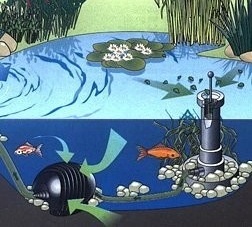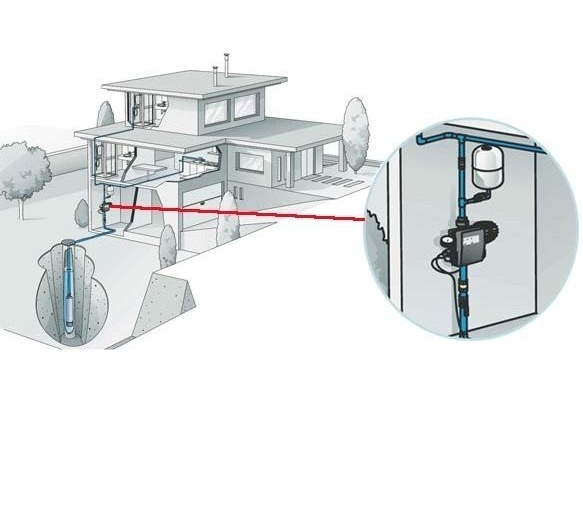Everything about the surface pump: device, types, selection tips and commissioning
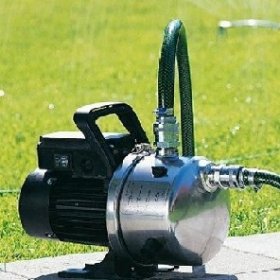
Suburban construction is gaining momentum every year. It allows you to solve the housing problem, guarantees fresh air and a beautiful view from the window. True, the infrastructure in most cottage villages is a big problem. Water supply is one of the most important. The well, of course, partially solves it, but the townspeople, accustomed to comfort, are not ready to put up with such a decision. In almost every area, an autonomous water supply system is installed or is already functioning. Somewhere in their core wells, somewhere wells. In the latter case, surface pumps for summer cottages are the best option. Firstly, they are affordable and easy to maintain. Secondly, with a pumping station, you can create comfortable living conditions. Everyone will be provided with water: a kitchen, a bathhouse, and a garden.
Content
Purpose and device of the surface pump
The surface pump does not require immersion; only the intake hose is lowered into the water. The maximum depth with which he will cope is nine meters. Therefore, it is not suitable for a well, but just for a shallow well or spring. In addition, such a pump copes well with pumping water from basements and watering a personal plot. And surface pumps are great for wells in quicksand.
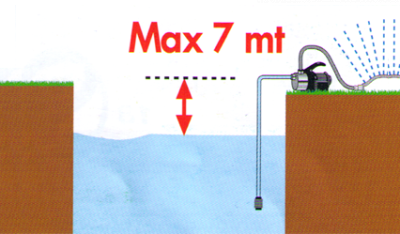
The maximum depth with which a surface pump can lift water is about seven meters. At the same time, the vertical-horizontal ratio must be observed: four meters horizontally per meter of vertical
Surface pumps can be of three types:
- vortex;
- centrifugal;
- pumps with an external ejector.
The first are the most affordable and compact. They create pressure 3-7 times higher than similar centrifugal ones, but have low efficiency - only forty-five percent. They can not be used for pumping water containing a large amount of sand or other impurities, as this leads to rapid wear of the impellers. Such a pump lifts water by means of a rotating shaft and a wheel on which the “blades” are located. The latter transmit water energy from the working axis.
The second ones are also not suitable for supplying heavily contaminated water, but they perfectly cope with air bubbles and traffic jams in the system. They are more expensive than vortexes, since they have more steps. This design works thanks to pressure boosting wheels. They are driven by a working shaft supported by bearing systems.
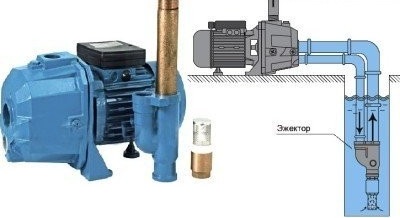
Installing an ejector significantly increases the maximum suction depth of the surface pump, but reduces its efficiency
Pumps with an external ejector are almost never used. They were replaced by submersible pumps, whose performance is much higher.
A wide range of submersible pumps is available on the market. Our site has reviews of some of them. For example, the unit "Trickle": https://aquatech.tomathouse.com/en/vodosnab/nasos/nasosy-otzyvy/nasos-rucheek.html.
Detailed analysis: the pros and cons of surface pumps
Surface pumps have many advantages:
- Compact overall dimensions;
- Light weight;
- Price availability;
- Easy installation, operation and maintenance. Installation of a surface pump does not require special knowledge, skills and experience;
- Ability to work with a water layer of less than 80 cm. Under such conditions, submersible pumps can no longer work;
- Air cooling, and not at the expense of water, as in submersible;
- A large pressure of water;
- High efficiency;
- No need to supply electricity to the water intake;
- High reliability and durability;
- Steady operation even in the presence of air jams in system.
Also, surface pumps (as a class of equipment) have several disadvantages:
- Sensitivity to the presence of sand, impurities and other water pollution;
- The maximum depth with which you can raise water is about nine meters;
- When using an ejector, the reliability and performance of the system is significantly reduced;
- Noise. For the operation of the surface pump, it is better to allocate a separate room;
- The need to fill the suction line with water.
What to consider when choosing a specific model?
Depending on the purpose for which the surface pump is purchased, the characteristics that you should focus on differ.
Garden watering pump
In this case, the main parameters of the equipment are:
- Performance. For watering the garden, one cubic meter per hour is enough;
- The suction depth at which the equipment will be operated. The surface pump lifts water from a maximum of nine meter depth. In this case, remember the vertical-horizontal ratio, which is one to four. When operating at a depth of two meters, the pump should be eight meters away from the well. If the suction depth exceeds four meters (or the total length of the supply line is more than twelve meters), increase the pipe clearance by ¼ inch;
- The pressure. You should focus on the most distant point of consumption.
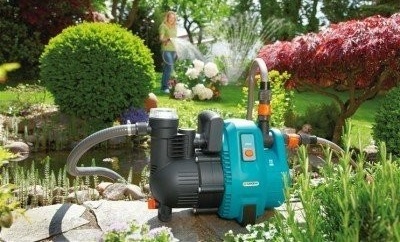
With the help of a surface pump, it is possible to organize irrigation of a personal plot without problems. The equipment is easy to install and does not require special skills during installation
To connect a surface pump, the following components are needed: hoses (for water intake and for irrigation); fitting for connecting the hose and pump; non-return valve and filter screen, which is installed on the non-return valve and traps sand and particulate matter.
High-quality hoses are the basis of a good water supply for watering the garden. You will learn about which pipes it is better to choose for these purposes in our material:https://aquatech.tomathouse.com/en/santehnika/snaruzhj/truby-dlya-poliva-ogoroda.html.
Pump for home water supply system
When choosing a surface pump designed for water supply of a country house, you need to focus on the amount of water consumed, the number of consumption points and the necessary pressure in the system.
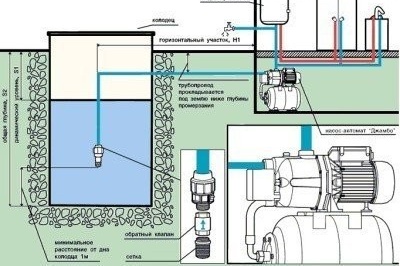
Designing a water supply system for a house based on a surface pump requires taking into account the amount of water consumed and the number of flow points
For simplicity of calculations, you can take the following values:
- House for a family of four consumes 3 m per hour3;
- Two-family house - 5 m3/hour;
- Four-Family House - 6 m3 in hour;
- The plot is about one cubic meter per hour.
In dry times, water consumption can increase significantly, on hot days only 40-55% more than usual will go to watering.
In addition to these parameters, you need to pay attention to accumulator. If a value of 3.5 atmospheres is set, then the maximum pressure in the system should be greater than the total horizontal and vertical pressure of the supply line (distance to water plus 45-50 meters). A distance of 10 meters vertically or 100 meters horizontally is equivalent to pressure in one atmosphere.
In addition to the pump itself, the following components will be needed to organize the water supply of the house:
- Connecting nipple;
- Inlet and outlet hose;
- Check valve with strainer;
- Hydraulic accumulator, the role of which is performed by a tank with a capacity of 30-60 liters. It must maintain pressure in the system;
- Flexible hoses for connecting the pump and tank;
- Five pin adapter for second output;
- Pressure gauge;
- Pressure switch. It connects to the five-pin adapter. It sets the pressure at which the pump will turn on or off.
How to connect and start the pump?
The choice of pumping equipment is only the first, although important, stage. Next, close attention should be paid to the connection diagram of the surface pump and its first start-up. The life of the equipment depends on this.
The surface pump must be installed on a stable surface before connecting. The equipment should be well fixed on it to avoid possible displacement of the case during operation. Then the incoming trunk is mounted. A check valve is attached to the hose on one side (it is then immersed thirty centimeters in water), and on the other, the pump itself. The horizontal length of the hose should be slanted towards the water intake. When connecting components, you need to use a fum tape or sealing tape.
The next step is to fill the system with water. It is necessary to completely shed the incoming line and pump. After that, the station is connected to the water distribution in the house. Be sure to close the filler hole if the pump was filled through it. The air pressure in the accumulator is checked and brought to threshold values. The pump is connected to the mains. Gradually, the entire line should fill up with water, then the accumulator tank. After the system reaches a pressure of 2.6-3.0 atmosphere, the pump should automatically shut off.
Surface pumps are also used in the arrangement of fountains on the site. Read more about this in our material:https://aquatech.tomathouse.com/en/vodosnab/font_bass/nasos-dlya-fontana-svoimi-rukami.html.
To check the water pressure, you need to open any tap. The pressure gauge needs to track the pressure value at which the pump will turn on again. If it differs from that recommended in the instructions, you need to adjust the switch and recheck again. After that, the system is ready for operation.
